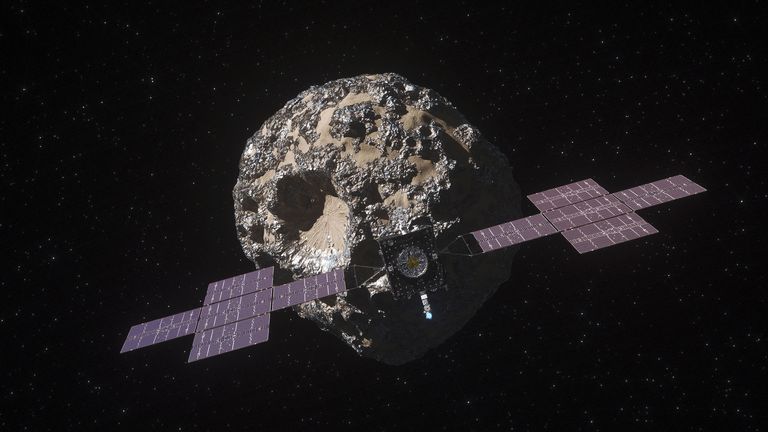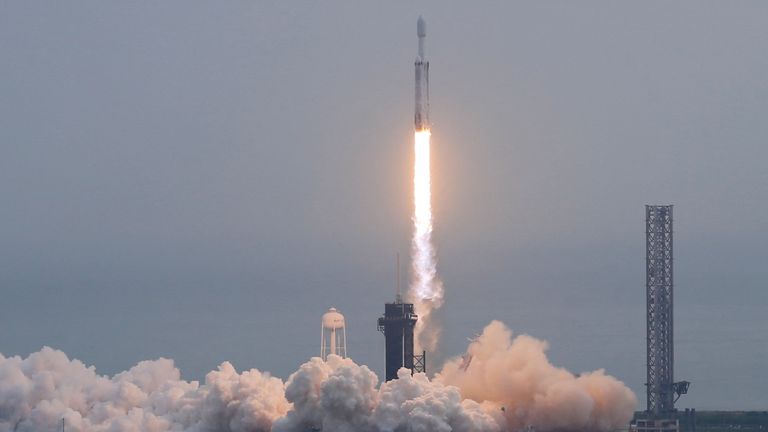NASA has launched a mission to a rare asteroid covered in metal that is two billion miles (3.6bn km) and six years’ travel time away from Earth.
Scientists hope exploring the Psyche asteroid will help them understand more about how Earth formed and what makes it habitable.
Lead scientist Lindy Elkins-Tanton, of Arizona State University, said: “It’s long been humans’ dream to go to the metal core of our Earth. I mean, ask [author] Jules Verne.
“The pressure is too high. The temperature is too high. The technology is impossible. But there’s one way in our solar system that we can look at a metal core and that is by going to this asteroid.”

??? Let’s mosh!
A @SpaceX Falcon Heavy has launched the #MissiontoPsyche spacecraft from Launch Complex 39A. The spacecraft has begun its journey to Psyche, the metal-rich asteroid located between Mars and Jupiter. pic.twitter.com/P8xd6dPwG2
— NASA's Kennedy Space Center (@NASAKennedy) October 13, 2023
Most asteroids tend to be rocky or icy, and this is the first look at a metal one – the team is also hoping to take the first-ever images of it.
Psyche, which may be the battered remains of a planetesimal, or a building block of a rocky planet, is the largest of the nine metal-rich asteroids discovered so far, NASA said.
The potato-shaped rock measures about 144 miles by 173 miles (232km by 280 km) at its widest and has a mass of about 440 billion pounds.
It will dwarf the van-sized spacecraft, with solar panels big enough to fill a tennis court.

(An illustration showing NASA’s Psyche spacecraft heading towards the asteroid. Pic: NASA/JPL-Caltech/ASU)
Also called Psyche, the spacecraft was launched on a SpaceX Falcon Heavy rocket from NASA’s Kennedy Space Centre, in Florida, on Friday.
The agency believes the asteroid, which orbits the sun between Mars and Jupiter, is brimming with iron, nickel and other metals – and quite possibly silicates. It is a dull grey colour, probably because its surface is covered with fine metal grains from cosmic impacts.
View from the second stage before the escape burn and deployment of the Psyche spacecraft pic.twitter.com/Z25P7gN9NA
— SpaceX (@SpaceX) October 13, 2023
Metal cliffs and lava flows
It was discovered in 1852 and named after Greek mythology’s captivating goddess of the soul.
As to what they will find, scientists imagine spiky craters, huge metal cliffs and metal-encrusted eroded lava flows that are greenish-yellow from sulfur. However, Ms Elkins-Tanton admitted that is “almost certain to be completely wrong”.
Tiny amounts of gold, silver, platinum or iridium – iron-loving elements – could be dissolved in the asteroid’s iron and nickel, she said.
“There’s a very good chance that it’s going to be outside of our imaginings, and that is my fondest hope.”
Believed to be a planetary building block from the solar system’s formation 4.5 billion years ago, the asteroid can help answer fundamental questions such as how life began on Earth and what makes our planet habitable, according to Ms Elkins-Tanton.










